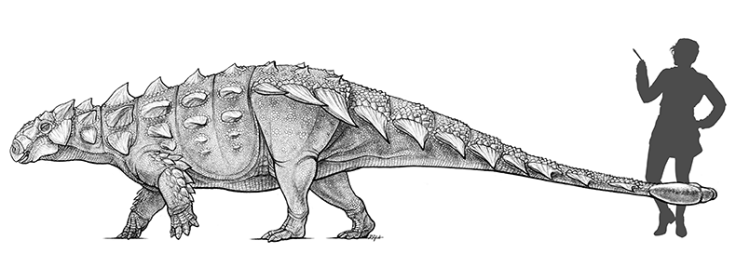‘Ghostbusters’ Dinosaur Zuul Discovered In Montana Had A Sledgehammer-Like Tail

UPDATE: 5 a.m. EDT — If you would like a closer 3D look at the skull of Zuul crurivastator, an animated model is available on the website of the Royal Ontario Museum. Go to this page and scroll down to an option in purple that says “Explore Zuul’s skull” and follow the simple instruction.
Original story:
Paleontologists from Canada’s Royal Ontario Museum (ROM) discovered the remains of a new species of dinosaur in the Judith River Formation of northern Montana, an ankylosaur that resembles the fictional monster Zuul from the 1984 movie, “Ghostbusters.”
Researchers who discovered it have chosen to name it after the monster, calling it Zuul crurivastator. The second part of its name means “destroyer of shins” and is a nod to the dinosaur’s sledgehammer-like tail. The powerful tail clubs and bony armor were features common to ankylosaurids, a group of ankylosaurs that were bulky quadrupeds with short limbs and mainly herbivorous.

Read: ‘Baby Dinosaur From China’ Largest Known To Incubate Its Eggs
The new-found “ankylosaur skeleton had four horns on the skull, one behind and one under each eye. It had large nostrils and elaborate ornamentation across the snout,” which helped identify the species as different from previously known members of the group, all of which had bony spikes, called osteoderms.
Zuul lived about 75 million years ago in the Cretaceous Period. Its powerful tail “could inflict serious damage on opponents, such as predatory theropods or maybe even other ankylosaurs competing for mates or territory,” according to a ROM statement explaining the tails. It called them “an amazing biological weapon and one of the weirdest and most recognizable features of ankylosaurs. The back half of the tail was stiff, and the tip of the tail was covered with large bony plates – together, these formed a sledgehammer or axe-like weapon. Zuul has a long tail with sharp, pointed spikes along the sides, and a large tail club.”

An adult Zuul was about 6 meters (20 feet) long and weighed over 2.5 tons.

The osteoderms that made ankylosaurids stand out among their peers were part of the skin, which usually fell away from the skeleton after the animal’s death. But in the case of Zuul, paleontologists found the osteoderms in their original positions, and some of the soft tissue along the body was also preserved along with the keratin coverings on the tail spikes.
Finding Zuul was accidental, as its skeleton was bumped into while excavating the fossils of a tyrannosaur at the same site. Zuul was buried under 12 meters of rock, and had it not been for the lucky accident, the skeleton would have perhaps remained hidden for thousands of years. The excavation is a part of the ongoing Southern Alberta Dinosaur Project which is led by a team from ROM. The Montana site is only about 25 kilometers (15 miles) away from the Canadian border.
Zuul’s skull and tail have been separated from the surrounding rocks, but its stomach and hips are in a separate large chunk of rock that weighs over 15 tons. It will be a few years before those can be prepared to reveal the bones and armor that covered those parts of Zuul’s body.
A paper describing the species was published in the journal Royal Society Open Science, under the title “A new ankylosaurine dinosaur from the Judith River Formation of Montana, USA, based on an exceptional skeleton with soft tissue preservation.”
© Copyright IBTimes 2024. All rights reserved.





















